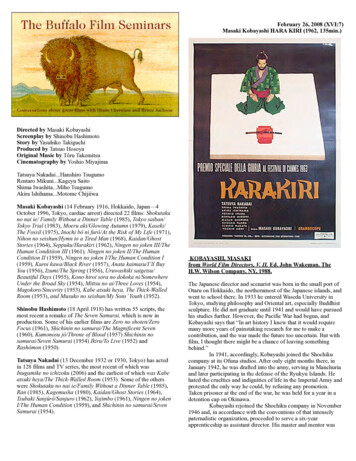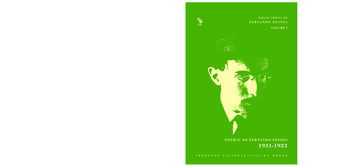
Transcription
Mervyn LeRoy Gold Diggers of 1933 19((117(117minmin.)minutes)February 26, 2008 (XVI:7)Masaki Kobayashi HARA KIRI (1962, 135min.)Directed by Masaki KobayashiScreenplay by Shinobu HashimotoStory by Yasuhiko TakiguchiProduced by Tatsuo HosoyaOriginal Music by Tôru TakemitsuCinematography by Yoshio MiyajimaTatsuya Nakadai.Hanshiro TsugumoRentaro Mikuni.Kageyu SaitoShima Iwashita.Miho TsugumoAkira Ishihama.Motome ChijiiwaMasaki Kobayashi (14 February 1916, Hokkaido, Japan—4October 1996, Tokyo, cardiac arrest) directed 22 films: Shokutakuno nai ie/ Family Without a Dinner Table (1985), Tokyo saiban/Tokyo Trial (1983), Moeru aki/Glowing Autumn (1979), Kaseki/The Fossil (1975), Inochi bô ni furô/At the Risk of My Life (1971),Nihon no seishun/Hymn to a Tired Man (1968), Kaidan/GhostStories (1964), Seppuku/Harakiri (1962), Ningen no joken III/TheHuman Conditiion III (1961), Ningen no joken II/The HumanCondition II (1959), Ningen no joken I/The Human Condition I(1959), Kuroi kawa/Black River (1957), Anata kaimasu/I’ll BuyYou (1956), Izumi/The Spring (1956), Uruwashiki saigetsu/Beautiful Days (1955), Kono hiroi sora no dokoka ni/SomewhereUnder the Broad Sky (1954), Mittsu no ai/Three Loves (1954),Magokoro/Sincerity (1953), Kabe atsuki heya, The Thick-WalledRoom (1953), and Musuko no seishun/My Sons’ Youth (1952).Shinobu Hashimoto (18 April 1918) has written 55 scripts, themost recent a remake of The Seven Samurai, which is now inproduction. Some of his earlier films are Zero no shoten/ZeroFocus (1961), Shichinin no samurai/The Magnificent Seven(1960), Kumonosu jô/Throne of Blood (1957) Shichinin nosamurai/Seven Samurai (1954) Ikiru/To Live (1952) andRashômon (1950).Tatsuya Nakadai (13 December 1932 or 1930, Tokyo) has actedin 128 films and TV series, the most recent of which wasInugamike no ichizoku (2006) and the earliest of which was Kabeatsuki heya/The Thick-Walled Room (1953). Some of the otherswere Shokutaku no nai ie/Family Without a Dinner Table (1985),Ran (1985), Kagemusha (1980), Kaidan/Ghost Stories (1964),Tsubaki Sanjûrô/Sanjuro (1962), Yojimbo (1961), Ningen no jokenI/The Human Condition (1959), and Shichinin no samurai/SevenSamurai (1954).KOBAYASHI, MASAKIfrom World Film Directors, V. II. Ed. John Wakeman. TheH.W. Wilson Company, NY, 1988.The Japanese director and scenarist was born in the small port ofOtaru on Hokkaido, the northernmost of the Japanese islands, andwent to school there. In 1933 he entered Waseda University inTokyo, studying philosophy and Oriental art, especially Buddhistsculpture. He did not graduate until 1941 and would have pursuedhis studies further. However, the Pacific War had begun, andKobayashi says that “In art history I knew that it would requiremany more years of painstaking research for me to make acontribution, and the war made the future too uncertain. But withfilm, I thought there might be a chance of leaving somethingbehind.”In 1941, accordingly, Kobayashi joined the Shochikucompany at its Ofuna studios. After only eight months there, inJanuary 1942, he was drafted into the army, serving in Manchuriaand later participating in the defense of the Ryukyu Islands. Hehated the cruelties and indignities of life in the Imperial Army andprotested the only way he could, by refusing any promotion.Taken prisoner at the end of the war, he was held for a year in adetention cap on Okinawa.Kobayashi rejoined the Shochiku company in November1946 and, in accordance with the conventions of that intenselypaternalistic organization, proceeded to serve a six-yearapprenticeship as assistant director. His master and mentor was
Kobayashi—Haraikiri—2Keisuke Kinoshita, a versatile, accomplished, but sometimessentimental mainstay of the Shochiku dream factory. Kobayashiassisted Kinoshita on fifteen movies—melodramas, social protestfilms, love stories, ghost stories, and satires (including BrokenDrum, which Kobayashu coscripted in 1949).In November 1952, eleven years after he first joined theShochiku company, Kobayashi completed his debut film,Musoko no seishun (My Son’s Youth). It was made very muchunder the supervision and influence of Kinoshita—an amiable,episodic shomin-geki (film of lower-middle-class life) about afather and his two teen-aged sons and the latters’ rivalries and firstdates. The movie’s mood was set by the sentimental scoresupplied by Chuji Kinoshita, the brother of Kobayashi’s mentor.In spite of the interminable apprenticeship that had preceded it, itwas praised for freshness and lyricism.And Kinoshita’s part inKobayashi’s second film was even more direct—by way ofcelebrating his assistant’s promotion, he wrote its script. This wasMagokoro (Sincere Heart, 1953), a highly characteristic Kinoshitastory about a student’s pure and hopeless love for a beautifulyoung invalid whom he can see only through her window.Kobayashi made his first break for freedom with his nextfilm, Kabe atsuki heya (Room With Thick Walls, 1953). He formedhis own production company, Shinei Productions, persuaded theShochiku company to handle distribution, and invited novelistKobo Abé to write the script. At that time Abé had no experienceof the medium Kobayashi says “he wrote something novelistic,and I went over it and made it into a real scenario.” Kobayashi hasfollowed this procedure ever since, however experienced hisscenarist: he is a perfectionist who likes as much control over thefilmmaking process as he can possibly secure.Room WithThick Walls is based on the diaries of lowranking Japanese war criminals. It shows through flashbacks thatmany of those who received long sentences committed atrocitieson the orders of superior officers who escaped unscathed, anexplosive revelation at that time. Moreover, though the film dealsmuch more harshly with the Japanese military than with theAmericans, there is some criticism of the latter, especially in thestory of a girl corrupted into prostitution by contact with theoccupation forces.It is said to have been for fear of offendingAmericans that Shochiku’s chief Shiro Kido shelved the film fornearly four years. Finally released in 1956, it won the PeaceCulture Prize, though later critics have found it overly concernedwith social criticism, too little with characterization.Returning to the Shochiku fold, Kobayashi then madefour films that gradually reinstated him in Shiro Kido’s favor.After Mittsu no ai (Three Loves, 1954), scripted by the directorand telling three separate love stories in the Kinoshita vein ofsentimental humanism, came Kono hiroi sora no dokoka ni(Somewhere Beneath the Wide Sky, 1954). A slice of lowermiddle-class life in the industrial city of Kawasaki, it was writtenby Kinoshita’s sister, Yoshiko Kusada, with a ascore by ChujiKinoshita. Two more lyrical shomin-geki dramas of petitbourgeois life and pure love followed in Uruwashiki saigetsu(Beautiful Days, 1955) and Izumi (The Fountainhead, 1956). Bothwere scripted by Zenzo Matduyama, who wrote or co-authoredKobayashi’s next five films as well.According to Audie Bock, Kobayashi’s instinct for selfpreservation within the Shochiku system was correct. In Kinoshitahe had an excellent teacher and powerful patron. While none ofthe early films he made under direct Kinoshita tutelage are badfilms, they are more his mentor’s late style than his own, and verydifferent from what Kobayashi already knew he wanted to do as adirector.”By 1956, he was well enough established at Shochiku towin approval for a more personal and controversial movie, Anatakaimasu (I’ll Buy You), an exposé of the corruption in professionalbaseball. Zenzo Matsuyama;s script centers on a ruthless talentscout and his efforts to recruit for his team a brilliant high-schoolstar. In the course of his successful campaign, he uses bribery,wrecks the boy’s relationship with his girl-friend, and interferes inhis family life. It is a totally pessimistic account of a system inwhich only the heartless opportunist can hope to survive.Another exposé followed in Kuroi Kawa (Black River,1957) investigating the prostitution, gambling, and gangsterismthat had grown up around American bases in Japan. It attacks notthe Americans but the Japanese social system, “which permittedlawlessness to go unpunished and even officially unnoticed.” Thefilm was in general very well received and launched the moviecareer of Tatsuya Nakadai, a young actor trained in the modern (asdistinct from classical) Japanese theatre. Now a major star,Nakadai has played lead roles in many of Kobayashi’s films,becoming his “personal representative on the other side of thecamera.”Donald Ritchie has praised in particular the last reel ofBlack River: “It is a rainy night and the jerry-built bars and pinballparlors, cheap restaurants and souvenir shops which have grownup around the camp entrance look like a deserted amusementpark. The young gangster, played by Tatsuya Nakadai, now deaddrunk, is being taken home by the girl, Ineko Arima, whom he hasseduced and who is now his mistress. There is an argument and heraces off down the long, rain-slicked highway. Along the roadcomes a convoy of American trucks. He slips in front of one ofthese and is killed. The girl drops her open umbrella and rushestoward him; the final shot shows the umbrella on the highwaywhile she, crying, runs toward the now stationary trucks. Theentire sequence is made up of short shots, gathering momentum tostop abruptly on the long-held final image.”Kobayashi’s next project, one of the most controversialever made in Japan, occupied him for four years. This was Ningenno joken (The Human Condition), a massive chronicle of worldWar II based on Jumpei Gomikawa’s best-selling six-volumenovel. Kobayashi read the book and bought the rights before itbecame a bestseller, but had to threaten to quit before Shochiku
Kobayashi—Haraikiri—3agreed to finance the picture. Adapted by Zenzo Matsuyama andthe director, the story was filmed in three parts, each more thanthree hours long; the complete movie entered the Guiness Book ofRecords as one of the longest films ever shown. Photographed inblack and white and ‘scope by Yoshio Miyajima, it has a score byChuji Kinoshita. The hero, Kaji, is played by Tatsuya Nakadai.The trilogy begins with No Greater Love (1959), set in1943. Kaji, a sensitive and humane young man, by inclination apacifist, escapes military service by taking a civilianadministrative post in a Japanese-controlled iron mine inManchuria. He finds that the kidnapped coolie workers andespecially the Chinese prisoners of war used as slave labor aretreated with a sickening barbarism against which he frequentlyprotests. But at times even Kaji is drawn into the general brutality,however reluctantly, as when he whips starving prisoners awayfrom cartloads of raw lentils that they are in no condition to eat.Seven prisoners who try to escape are condemned to death andthree have died in a horrific public beheading before Kajiintervenes, halting the execution. As a result, he is himselfarrested by the military authorities, interrogated, tortured, andfinally released, only to receive his army draft papers.A hotly debated success in Japan, No Greater Love wonthe San Giorgio Prize at Venice. It seemed to Derek Hill “amasterpiece, one of the cinema’s handful of truly greatproductions .The hero .seems the embodiment of the world’sconscience. His weaknesses are as honestly set forward as hisstrength; and a nagging conclusion reminds us—and him—that hewill never forget letting three men die before he mustered hiscourage.” This is one of the trilogy’s principal themes—Kaji isboth oppressor and oppressed, and Kobayashi believes that “thistragic dual nature is something which all Japanese experienced,some more than others, during the war.” Elsewhere he has said: “Iam Kaji.”Road to Eternity (1959) opens with Kaji in training at adesolate army camp, where the recruits are mistreated andbrutalized almost as shamefully as the prisoners had been in theearlier film. Promoted to instructor, Kaji tries to ameliorate theharshness of the regime, earning the hostility of his fellow officersand a reputation as a “red.” When at last they go into action,Kaji’s unit is wiped out by Soviet forces, primarily because theyoung soldiers have not been trained to think from themselves,only to follow orders. In the end, Kaji is one of three survivors.The trilogy concludes with A Soldier’s Prayer (1961).After the Japanese surrender, Kaji and other refugees are capturedby the Russians. He has been an idealistic socialist, looking toRussia as “the land of freedom,” but he finds himself and theother prisoners used as slave labor and treated as barbarically asthe prisoners in the Manchurian mines. Kaji is once more inconflict with authority, and in the end, desperate to return to hiswife, he escapes into the snowy wilderness. Making a superhumaneffort, he treks across Siberia but dies before he can reach theborder, betrayed equally by Japan and by Stalinism. “To me hisdeath was actually a resurrection,” Kobayashi has explained. “Hehad to die there. With his death he lives in the minds of people fora long time as a symbol of the hope that we can eradicate thehuman tragedy of war.” Like the rest of the trilogy, A Soldier’sPrayer was based on fact: of the half-million Japanese soldierscaptured by the Russians in 1945, fewer than 30,000 returnedhome; the rest perished in Soviet labor camps.As Audie Bock says, Kobayashi in The Human Conditionattacks above all “the loss of emotion. It is this emotional rigidity,the negation of common feeling with one’s fellow man, thatthreatens life itself.” It is a theme that recurs in his work, andanother such, the sanctity of the family, emerges in the way Kaji issustained through his ordeals by thoughts of his wife. Critics inthe West were astonished by the trilogy’s”terrible frankness”—theuncompromising nature of its national self-criticism—but itseemed to Donald Ritchie that in general the work “is moreinterested in society than it is in people,” sacrificing “character toaction.”For many, however, as for David Shipman, The HumanCondition is “one of the least seen and known cinemamasterpieces.” Shipman says that “Kobayashi fully intended anepic. Steeped as much in Homeric and Biblical myths as those ofJapan, he set out to create a man on the scale of Ulysses orMoses .At the beginning [Kaji] is little more than anexpression of guilt, but.he emerges hugely, a man thatMichelangelo might have carved: not man himself, but man thedoer of good .Kobayashi can be accused of over-simplificationin making his points, but he has created a teeming world whichlives on in the consciousness.”Karamiai (The Entanglement/ The Inheritance, 1962) is,like I’ll Buy You, a film of anti-materialist social comment, aboutwhat happens when a dying patriarch decides to leave his fortuneto his illegitimate children. In the search for these heirs,blackmail, imposture, and even murder come into play. Apartform one of the old man’s sons—a violent but not unattractiveinnocent—none of the characters in this bleak parade ofheartlessness and avarice shows any sign of human feeling or anycapacity for enlightenment, and critics found it hard to sympathizewith such unrelenting pessimism.Kobayashi tried his hand at a quite different genre inSeppuku (Harakiri, 1962). This is a jidai-geki, a period film inwhich the past is explored for what it can teach the present.Brilliantly adapted by Shinobu Hashimotu from a novel byYasuhiko Takiguchi, this film is set in 1630 when, at the end of anera of civil strife, many samurai found themselves to be ronin—masterless warriors. They were still, however, bound by thesamurai code, which forbade them all other employment. Sincefew of the victorious lords had any immediate need for morewarriors, many ronin were faced with the grim choice of dishonor,starvation, or ritual suicide—seppuku. On rare occasions, a roninwould approach some noble household and ask to performseppuku there, in the hope and expectation that he would insteadbe offered suitable employment.At the beginning of Seppuku, a ronin named Tsugumo(Tatsuya Nakadai) presents himself at the degenerate House of Ii.He is informed that he will be taken at his word in his expresseddesire to commit suicide, and in flashback we are told the story ofa younger samurai who had been forced by the House of Ii tofollow the appalling ritual to the bitter end, though he had pawnedhis sword—the samurai’s “soul”—and had only a bamboo bladewith which to perform the required disembowelment.Tsugomo then reveals that he is the father-in-law of thistormented young martyr to the code of Bushido. He has come tosee that his son-in-law was right to pawn his sword for the sake ofhis family—that our honor merely adorns the surface.” And he hasfollowed the young man to the House of Ii to wreak vengeance. Ina climactic and brilliantly choreographed battle, Tsugimo wipesout the cream of the Ii swordsmen. Finally, dishonorably woundedby the new flintlock muskets, he commits suppuku, in the processtearing down the ancient suit of armor that symbolizes the honorof the House of Ii. A hypocritical entry in the Ii record bookpasses blandly over these disgraceful events.
Kobayashi—Haraikiri—4Seppuku is as pessimistic as the film that preceded it,and in fact Kobayashi regards the inhumanity of the feudal era asidentical with that of the Imperial Army in World War II. He saysthat he approaches period films just as he does contemporary ones—that he understand “the past as the present.” In an interviewwith Joan Mellen, Kobayashi states, “Since I am inclined tobelieve that wars will continue, you might say that I do not seemuch prospect for a changed society. However, we must live on,and to do this, we must have hope .Both Seppuku and TheHuman Condition end as tragedy. But my underlying themetranscends that. I try to express the possibility that human beingscan overcome the tragic events of the world.”Seppuku was generally recognized as an importantadvance for Kobayashi, beginning “a new exploration of formalbeauty.” Photographed by Yoshio Miyajima, it is, as Joan Mellensays, “characterized by sharp contrasts in black and white withstark and ascetic geometrical shot compositions, at onceformalistic and cold,” to emphasize the rigidity of the clan systemand its lack of softening humanity. The film received the SpecialJury Prize at Cannes and caused a sensation in Japan, whereKobayashi at once joined the ranks of the masters of the samuraifilm. Donald Ritchie considers Seppuku his “single finest film,”and many agree.This success brought Kobayashi what was then thebiggest budget ever granted in Japan, for his next film Kaidan(Kwaidan, 1964), which he had been preparing for years. It ismade up of four tales drawn from Lafcadio Hearn’s versions oftraditional Japanese ghost stories: “Black Hair,” “The SnowPrincess,” “Earless Hoichi,” and “In a Cup of Tea.” Againphotographed by Yoshio Miyajima, this was Kobayashi’s firstcolor film and continued his “exploration of formal beauty.” Hesays that his “main intention in the film was to explore thejuxtaposition between man’s material nature and his spiritualnature, the realm of dream and aspiration .I also enjoyedconveying the sheer beauty of traditional Japan.By this time Kobayashi “felt that I had come to the endof pursuing realism in film,” and in Kwaidan he “intended toexpress.the ultimate in stylized film method.” Seeking absoluteformal control, he took over an unused airplane hangar, built allhis sets inside it, and painted them himself. Filming proceeded athis own pace—never more than three final takes a day, often onlyone. Toru Takemitsu, the avant-garde composer who had providedthe interesting electronic score of Seppuku, and who wasthereafter Kobayashi’s regular composer, excelled himself withKwaidan, fitting to each story musical background dominated byelectronic variations on some appropriate sound—of an ancientmusical instrument, of wood being split, or of stones being struck.Lacking the social concerns of Kobayashi’s other work,Kwaidan is a gorgeous multicolored scroll.based on the lines andtones of an India-ink brush painting,” and is considered by someone of the most elegant films ever made. Critics seemedparticularly taken by the story of “Earless Hoichi,” about a blindyoung monk forced by the spirits of ancient warriors to tell thestory of their great battle over and over in the abandoned cemeterywhere they meet by night. To break the spell, Hoichi’s abbot hasevery inch of the boy’s body covered by sacred writing, butforgets his ears. Hoichi is released from his terrible bondage buthis ears are claimed in revenge. It seemed to Pierre Billard thatwhat Kobayashi had done in Kwaidan was “to invite the hereafterto cooperate with the visible and concrete world, to defend, exalt,and sing all the ways of humanity, and to affirm that man in hiswounds and dreams remains that infinitely small residue thatgives the world its true meaning.” The most successfulcommercially of all Kobayashi’s films, it again brought him theSpecial Jury Prize at Cannes.In Joiuchi (Rebellion/ Samurai Rebellion, 1967) matchedTatsuya Nakadai against Kurosawa’s jidai-geki star ToshiroMifune in another indictment of the feudal code and its disregardfor the individual. Mifune plays a samurai whose son is ordered tomarry the lord’s discarded concubine. They have been veryhappily married for two years when the lord demands thewoman’s return, her son having become his heir. The samuraifamily rebels, and the film ends in a bloodbath culminating in afight between Mifune and Nakadai that, for Richard N. Tucker,had “all the classic grace and control of high art.” Returning to a contemporary theme, Kobayashi oncemore attacked the inhumanity of war in Nippon no seishun (TheYouth of Japan / Hymn to a Tired Man, 1968), a “rather strident”film adapted from a novel by Shusaku Endo .By this time, the once vast and booming Japanese filmindustry was in decline, with little inclination to attempt anythingbut exploitation movies. At the beginning of the 1970s Kobayashideveloped one project after another but, he says, “all of them wererejected and all of them were social criticism films.” Seekingsome way to continue serious filmmaking, Kobayashi joinedforces with Kurosawa, Kinoshita, and Ichikawa in a group calledYonki no Kai (“The Club of the Four Knights”). At first theywasted much time and money attempting a collaborative scriptand then, finding they were all too individualistic to agree, turnedreluctantly to television, each director to make a separate film.The subject Kobayashi suggested for himself wasYasushi Inoue’s novel, Kaseki. Inoue’s books had always resistedadaptation, and the story was one that would require expensivelocation shooting in Spain and France, but to Kobayashi’ssurprise, his colleagues in Yonki no Kai approved. Adapted byShun Inagaki as a serial of eight oine-hour parts, Kaseki wasfilmed in three months, including sixty days on location inEurope. It was, as Kobayashi says, “a hard schedule, exceedingthe limit of human endurance”—shooting in Paris in bitter cold,
Kobayashi—Haraikiri—5he worked even on New Year’s day, abandoned by all but hisintensely loyal Japanese crew. Kobayashi has no use for televisionand reportedly didn’t watch the serial when, in 1972, it was shownwith great success on Fuji-TV. He had privately intended from thebeginning to edit the work down for feature release, and the filmfinally appeared in 1975, cut from eight hours to 213 minutes .Kobayashi used a voice-over commentary in Kasekimostly in an attempt to preserve the feel of Inoue’s novel, but thetechnique, “materially altering the way images are perceived,”seemed to one critic a fascinating “exploration of the territorybetween film and literature,” while Inoue himself said that “thecamera has caught what I could not express with my pen.” Therewas a chorus of praise for the truth and depth of Shin Saburi’sperformance in the lead, and another for Kozo Okazaki’s colorphotography, which captures “each aspect of the French, Spanish,and Japanese locales in breathtaking fashion as if we, too, areseeing through the heightened perspective of Itsuki.” PenelopeGilliatt called the film “a marvellous piece of work, which comesto terms with bedrock subjects usually out of film’s depth.”According to Audie Bock, Kobayashi denies that Kasekiconstitutes a change of direction, but as she points out, humanismin it emerges “in an entirely new light for Kobayashi,” with theimplication that man’s proper study is not society but self. This isarguably the theme of his next feature, Moeru aki (GlowingAutumn), made five years later and filmed partly on location inIran (where Kobayashi hoped eventually to make a film version ofInoue’s Tun-huang) .Tokyo Saiban (The Tokyo Trials, 1983).is anextraordinary historical document, making exemplary use ofarchival and newsreel footage. It is an exhaustive account of thecourt proceedings of the International Military Tribunal for theFar East between May 1946 and November 1948. During theseproceedings, intended by the Allies as the Pacific counterpart ofthe first Nuremberg trial, twenty-eight important Japanesegenerals, admirals, and politicians were tried for involvement inwar crimes. There were twelve Allied judges, and at theconclusion of the proceedings, all the defendants were foundguilty in some degree. Seven, including former Prime MinisterHideki Tojo, were hanged.Kobayashi viewed 30,000 reels of Pentagon footage tomake The Tokyo Trials. To put the period in perspective, he beginshis film with background material, referring to the RussoJapanese War of 1904-1905 and the Japanese invasion ofManchuria in the 1930s, among other things. However, the mainbody of the film concerns the immediate postwar reckoning.Intended primarily for a domestic audience, The Tokyo Trialsgives little sustained attention to the atrocity charges, althoughKobayashi, the pacifist and former POW, does attempt to placethese crimes in a context of war and militarism. But it is thecourtroom drama—the spectacle of the victors condemning thevanquished across a gulf of mutual incomprehension, inproceedings of dubious legality—that becomes the focus ofinterest. David Stratton writes that “Kobayashi is extremelyselective in his use of material, but he makes a compulsive dramaout of it .It’s often the small details that impress: a Japaneseofficial doffs his hat and a piece of paper falls out of it onto thefloor; the judges are caught napping or looking desperately bored;an MP removes prisoner’s headphone before he’s finishedlistening to a translation, and he angrily snatches it back.”Originally four and a half hours long,but edited down slightly forinternational release, The Tokyo Trials was made in conjunctionwith Kodansha, one of Japan’s leading publishers, as a project tocommemorate the firm’s seventieth anniversary. The topic wasselected because of recent interest on the part of the Japanesepublic.Shokutaku no Nai Ie (The Empty Table, 1985).is set inthe early 1970s. It is a fictional work but uses as its basis a realconfrontation between Japanese terrorists and police at theradicals’ mountain hideout . Derek Malcolm found “the statelyprogress of Kobayashi’s beautifully shot and constructed film”more reminiscent of Kaseki than of The Human Condition, “butits cumulative effect is as considerable, and underlined by somemagnificent ensemble playing. Kobayashi is actually attacking theconservatism of Japanese life, even when the film appears to bevery much part of it in mode. Nowhere is this more apparent thanin the performance of the actress who plays the engineer’s wife,driven towards mental breakdown by the shame of her situation.The Empty Table is a formal, often reticent film, but the scenewhen she smashes the fish tank and tries to swallow the live fishcomes like an emotional thunderclap . What strikes one mostabout the film is that its classical restraint seems merely a maskthrough which we gradually see the terrible turmoil of.peopledriven by circumstances to abandon centuries of tradition in orderto make their way out of the morass. Kobayashi’s calm, measuredfilmmaking makes his final position clearer than any amount ofmore emotional work might have done.”Audie Bock describes Kobayashi as “a tall soft-spokenman who always wears a hat” and still maintains his interest inancient art. A cousin of the great actress Kinuyo Tanaka, he is ameticulous perfectionist who has made relatively few films byJapanese standards.Speaking of the main body of his work, Richard N.Tucker writes that Kobayashi’s heroes “all face a system of rigidvalues, a system in which they have given place and a code ofbehaviour they are expected to folow. The act of becoming anindividual and discovering one’s own way is the raison d’étre ofKobayashi’s central characters—he has “maintained a consistentrebellion against the central traditions of the Japanese way of life”in films that “rise clear of simple social criticism into the realm ofmajor art.”Harakiri: Kobayashi and History. Joan Mellen. CriterionCollection 2005Japanese director Masaki Kobayashi came of age in thepostwar moment, a time when filmmakers were at the vanguard ofdissident expression in that country. Drawing upon a rich historyof protest in Japanese cinema, which had fallen dormant duringthe war and occupation years, filmmakers seized the opportunityto challenge those institutions that remain wedded to the nation’sfeudal past. Of this generation of directors, none was as passionateas Kobayashi. Every one of his films, from The Thick-WalledRoom (1953) to the feature documentary Tokyo Trial (1983) toThe Empty Table (1985), is marked by a defiance of tradition andauthority, whether feudal or contemporary. Kobayashi found thepresent to be no more immune to the violation of personalfreedoms than the pre-Meji past, under official feudalism. “In anyera, I am critical of authoritarian power,” Ko
Room (1953), and Musuko no seishun/My Sons' Youth (1952). Shinobu Hashimoto (18 April 1918) has written 55 scripts, the most recent a remake of The Seven Samurai, which is now in production. Some of his earlier films are Zero no shoten/Zero Focus (1961), Shichinin no samurai/The Magnificent Seven (1960), Kumonosu jô/Throne of Blood (1957 .










